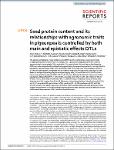Seed protein content and its relationships with agronomic traits in pigeonpea is controlled by both main and epistatic efects QTLs
Date
2020Author
Obala, Jimmy
Saxena, Rachit K.
Singh, Vikas K.
Kale, Sandip M.
Garg, Vanika
Kumar, C.V. Sameer
Saxena, K. B.
Tongoona, Pangirayi
Sibiya, Julia
Varshney, Rajeev K.
Metadata
Show full item recordAbstract
The genetic architecture of seed protein content (SPC) and its relationships to agronomic traits
in pigeonpea is poorly understood. Accordingly, fve F2 populations segregating for SPC and four
agronomic traits (seed weight (SW), seed yield (SY), growth habit (GH) and days to frst fowering
(DFF)) were phenotyped and genotyped using genotyping-by-sequencing approach. Five high-density
population-specifc genetic maps were constructed with an average inter-marker distance of 1.6 to
3.5cM, and subsequently, integrated into a consensus map with average marker spacing of 1.6cM.
Based on analysis of phenotyping data and genotyping data, 192 main efect QTLs (M-QTLs) with
phenotypic variation explained (PVE) of 0.7 to 91.3% were detected for the fve traits across the fve
populations. Major efect (PVE≥10%) M-QTLs included 14 M-QTLs for SPC, 16 M-QTLs for SW, 17
M-QTLs for SY, 19 M-QTLs for GH and 24 M-QTLs for DFF. Also, 573 epistatic QTLs (E-QTLs) were
detected with PVE ranging from 6.3 to 99.4% across traits and populations. Colocalization of M-QTLs
and E-QTLs explained the genetic basis of the signifcant (P<0.05) correlations of SPC with SW,
SY, DFF and GH. The nature of genetic architecture of SPC and its relationship with agronomic traits
suggest that genomics-assisted breeding targeting genome-wide variations would be efective for the
simultaneous improvement of SPC and other important traits.
Collections
- Research Articles [23]

